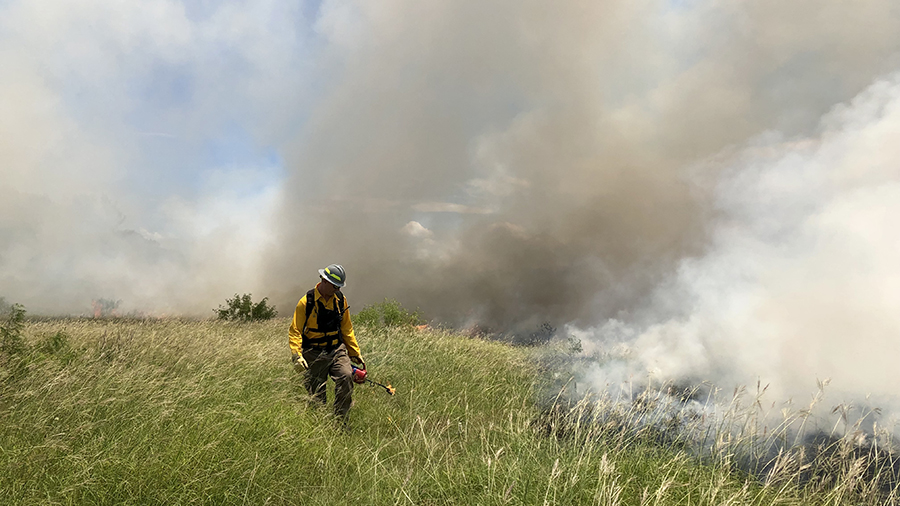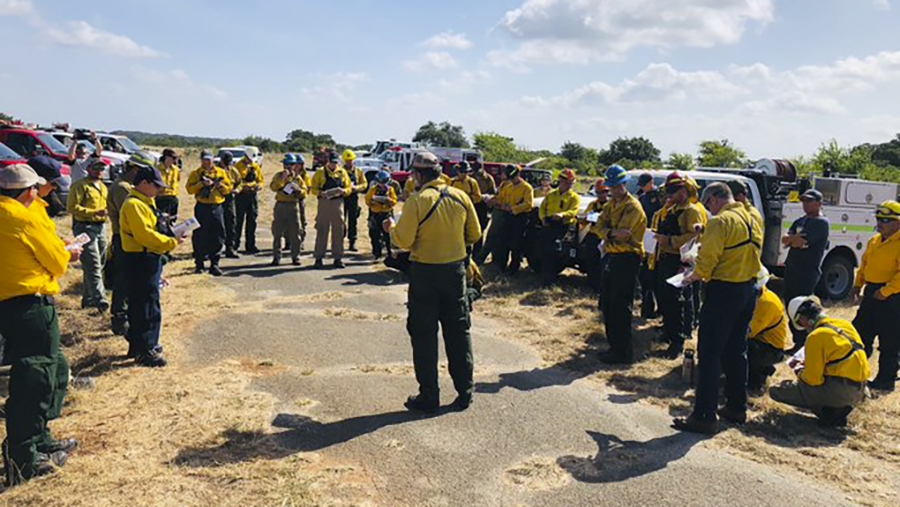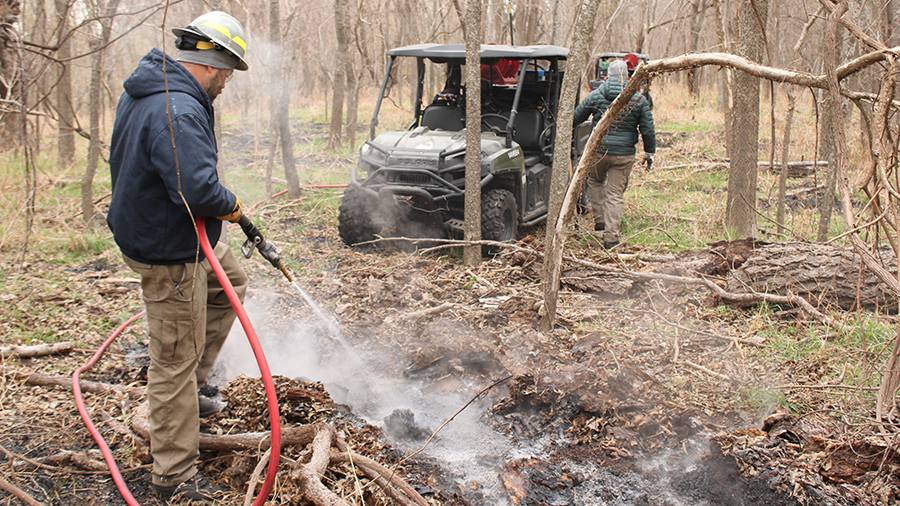Prescribed fire is a tool that land managers across the world have used for decades to restore habitat, improve rangeland health, improve forest health, reduce wildfire risk, and protect water supplies. In Austin parks and preserves, land managers use prescribed fire to restore native plant communities and reduce wildfire risk. Ecosystems in the Austin area developed over thousands of years with natural fires occurring periodically. As a result, many local plant communities thrive when fire is applied under very strict conditions. When applied appropriately, prescribed fire can help control exotic species, reduce fuel loading, and improve structure and diversity.
Plans for Upcoming Prescribed Burns
Plans for conducting prescribed burns at Austin parks and preserves will be listed in this section as details become available:
Winter, Spring, Summer 2025:
- Onion Creek Wildlife Sanctuary (broadcast and pile burns)
- Blunn Creek Nature Preserve (pile burn only)
- Decker Tallgrass Prairie Preserve (firefighter training only)
Pile Burns
.jpg)
A brush pile burns under the watchful eye of a trained fire manager.
Pile burning refers to the use of prescribed fire to consume cut and piled material (slash) that is generated from a forest thinning project. Pile burning is a common practice among public and private landowners across the country. These projects use precise specifications regarding tree species and size classes to selectively reduce overcrowding and improve the overall health of a forest. The remaining slash is organized into small piles, usually 4-5 feet in diameter, scattered throughout a management unit. Piles are allowed to dry for several months before they are individually burned by professionals working within a prescription that considers weather conditions, smoke management, etc.
.JPG)
Fire managers use prescribed fire to improve forest health.
This technique is used when a forested area is too dense to carry a broadcast prescribed fire (which is a fire that moves along the ground), or when surrounding conditions require very precise smoke management. Pile burning allows the Burn Boss to precisely manage the amount of smoke produced while fire consumes slash and improves the structure of the forest.
.JPG)
Prescribed fire requires extensive planning, permitting, and preparation.
Pile burning requires the same amount of planning, permitting, and preparation as broadcast burning. Professionally trained staff execute the burn. Austin Fire Department is usually on site with contingency resources.
.JPG)
A fire manager monitors a pile burn.
Managing forests with mechanical equipment is costly. Prescribed fire is the best and most cost-effective tool land managers can use to restore health to local parks and preserves. Selective thinning and brush pile burning allows land managers to make use of fire under conditions not conducive to broadcast prescribed fire. As a result, restoration can occur across a greater portion of parklands.
Broadcast Prescribed Fire

Trained staff using a drip torch to ignite a prescribed fire.
Prescribed Fire Process
Initially, an extensive site analysis is conducted to determine if prescribed fire is an appropriate management tool. This analysis includes classifying and mapping vegetation, determining management goals, analyzing current and future development and land use patterns adjacent to the property, mapping transportation corridors nearby, and determining if usual seasonal weather patterns and wind directions allow for appropriate smoke management. If it is determined that periodic fires are needed to restore or maintain ecosystem health and can be implemented safely on a given site, we begin the prescribed fire planning process, which typically occurs for a year or more prior to implementation.
One year or more from implementation
- Personnel survey the site and determine achievable goals.
- Personnel assess management goals and adjacent land uses.
- Personnel identify individual burn units to facilitate accomplishing prescribed fire.
- Personnel develop measurable fire objectives to accomplish within burn units.
- Personnel develop appropriate fire prescription (season, weather and fuel parameters, fire intensity, etc.) and methodology.
- Personnel prepare or improve the boundaries of burn units where fuel loading is reduced to facilitate equipment and personnel access and to help contain fire spread.

A fire line between burn units. Area on the left burned in October 2022. Area on the right unburned. Photo taken December 2022.
Months from implementation
- Personnel complete site-specific burn plans including implementation, monitoring, outreach, notifications, and contingency plans.
- Personnel secure appropriate permitting. All burn plans for Austin parks are reviewed by multiple fire management professionals including Austin Fire Department (AFD) Wildfire Division staff and permitted by Austin Fire Department.
Weeks from implementation
- Personnel monitor fuel (vegetation) moisture content and weather forecast and for potential days within burn prescription parameters.
- Personnel begin advance notifications to cooperators, relevant agencies, and neighbors should vegetation and weather parameters indicate possible opportunities to burn.
- Personnel secure and organize personnel and equipment to conduct the prescribed burn during the target window of opportunity. Burns are led by a City of Austin “Burn Boss” and implemented by trained City of Austin staff supported by a cooperative of regional land management agencies as well as the Austin Fire Department.
- Personnel execute final preparations to fuel (vegetation) along fire lines.
%20small.jpg)
Some of the small equipment used on a prescribed fire.
Days from implementation
- If weather and fuel moisture data indicate a burn opportunity is highly likely, the Burn Boss confirms availability of personnel and resources for the target date.
- Burn Boss provides the briefing time and location to personnel.
- Personnel distribute notifications to appropriate agencies, neighbors, and agency chain of command of likely burn on target date.
- Personnel distribute broader community notifications via social media, direct communications, and/or informational signs at appropriate locations near the burn unit.

Interagency personnel assembled for briefing prior to a prescribed fire.
Day of implementation
- Personnel acquire customized "spot weather forecast" from National Weather Service and acquire most current fuel moisture and fire behavior indices from Texas Interagency Coordination Center to ensure conditions and expected fire behavior are within prescription.
- Final notification of intent to burn is sent to required agencies and chain of command.
- Personnel and equipment arrive at the burn unit.
- Crews conduct the final survey / scouting of the burn unit to ensure site preparedness.
- Crews assemble for briefing and assignments to accomplish goals for the day.
- Weather data is taken on site and if all is within parameters, the decision is made to conduct the “test fire”.
- A small test fire is ignited within a portion of the burn unit. Fire behavior is observed and recorded to ensure it is within expectations.
- If all is within prescription, the Burn Boss determines final “go / no go” for the remainder of the burn.
- If ignition is approved, crews assume positions, and the burn plan is implemented for the unit with appropriate decision points identified to allow operations to change as needed.
- On-site weather data, smoke production, and fire containment are monitored throughout the operation.
- Upon completion, crews reassemble for an after-action briefing; non-critical resources are released.
- Operations to “mop-up” continue into the evening. This includes extinguishing areas of heavy smoke production, addressing safety hazards, and extinguishing burning material in a continually widening boundary around the perimeter of the burn unit.
- Personnel leave the site when the burn is fully contained and is safe to “hold” overnight. Personnel do not remain on-site throughout the night.
- The burn unit will often continue to smoke and smolder overnight. Glowing coals are often visible within the unit. These will be left to smolder if they do not present a risk of fire escaping the unit.

Crews extinguish coals after a prescribed fire.
Days after prescribed fire
- Personnel and equipment return early the following day.
- Personnel monitor the unit to ensure the burn is fully contained.
- Patrols continue as needed, often for several days. Some woody material such as logs, stumps, and leaf litter continue to smoke and smolder. This material is allowed to smolder if it does not present a risk of spreading fire outside the unit and smoke impacts are not significant.
- Follow-up notifications are made, as needed.
- Public access is re-opened as soon as possible.
- Equipment is rehabilitated and prepared for the next prescribed fire.
- Reports are completed / submitted to appropriate agencies.
View Lands Treated with Prescribed Fire
Commons Ford Ranch Metropolitan Park
University of Texas Ladybird Johnson Wildflower Center
Frequently Asked Questions
Q: How do burn bans impact prescribed fire plans?
A: Most burn bans in Travis and adjoining counties, as well as PARD burning restrictions, allow prescribed burns to be conducted during burn bans provided they are conducted by a Texas Certified and Insured Prescribed Burn Manager, certified by the Texas Prescribed Burning Board under Section 153.048, Natural Resources Code, and meet the standards of Section 153.047, Natural Resources Code. The Texas Legislature recognizes prescribed fire as an important tool for managing agricultural and natural resources as well as for reducing wildfire risk. Section 153 of the Natural Resources Code established the Texas Prescribed Burning Board as well as the standards for Texas Certified and Insured Prescribed Burn Managers. Prescribed burns may be, and often are, conducted during county burn bans provided conditions are within prescription, adequate resources are available, and there are no other circumstances that would make the burn infeasible or unsafe.
Q: What kind of training and qualifications do staff maintain?
A: PARD and each of its cooperating agencies follow the training and operational standards of the National Wildfire Coordinating Group (NWCG). The NWCG sets the wildland fire standards for all federal agencies in the United States, such as the National Park Service, US Fish and Wildlife Service, US Forest Service, Bureau of Land Management, and many others. NWCG standards are open-source and may be adopted by any organization involved in wildland fire management. The Burn Bosses for PARD and for many of our cooperators are also Texas Certified and Insured Prescribed Burn Managers, certified by the Texas Prescribed Burning Board.
Q: What precautions are taken to ensure a prescribed fire stays within the target area?
A: Each prescribed fire is the result of a long process of planning, permitting, and site preparation resulting in a burn plan specific to that site. The burn plan details weather and fuel moisture parameters within which a prescribed fire is allowed. This is termed the “prescription.” The prescription serves to identify conditions optimal for containment while accomplishing management goals. Beyond the prescription, each burn unit is delineated by “fire lines” which are lanes that have been cut or cleared of vegetation (fuel) to allow access for personnel and equipment and aid in containment. Crews with a variety of large and small equipment, including wildland fire engines, hand tools, and sometimes even aerial drones, actively monitor fire lines to ensure no embers cross.
Q: Is the fire department on site during a prescribed fire?
A: Yes. AFD’s Wildfire Division not only works with prospective applicants to navigate the permit process and provide technical review of burn plans, but also provides a company officer at the site to serve as the Conversion Officer. The Conversion Officer ensures there are adequate resources to meet the complexity of the burn and provides additional personnel and equipment if needed. The Conversion Officer is authorized to halt burning activities at any time if predetermined safety thresholds are not met. The Conversion Officer coordinates with the Burn Boss should a prescribed fire escape containment or become a significant threat to life or property.
Q: Why doesn’t the fire department conduct the prescribed fire?
A: No single entity in the central Texas region can conduct all the prescribed burns needed to meet natural resource management and wildfire mitigation goals. Therefore, several city departments and other agencies have created cooperative agreements that allow them to work together. Following NWCG standards as a common framework allows federal, state, county, city, and non-profit entities to work together seamlessly to jointly implement burns where they are most needed. Thus, PARD and AFD staff collaboratively determine which department will fill lead and supporting roles on each burn.
Q: What are the impacts of smoke on local air quality?
A: Each prescribed fire is the result of a long process of planning, permitting, site preparation, etc., resulting in a burn plan specific to that site. Fuel type, burn techniques, and wind patterns (surface and aloft) determine the volume of smoke production and how it travels. The burn plan includes smoke management strategies to minimize impacts to local air quality.
Most smoke impacts occur within about a quarter of a mile downwind from the burn unit. Burn managers work to eliminate or minimize smoke impacts to sensitive receptors within this area. Sensitive smoke receptors include roads, homes, businesses, schools, and medical facilities. Beyond about a quarter of a mile downwind from the burn unit, smoke is often visible, and a light odor may be present, but smoke is typically not bothersome or disruptive.
Techniques that burn managers use to minimize smoke impacts include: reducing the size of burn units, burning under weather and fuel conditions that limit smoke production, ensuring winds carry smoke away from the most sensitive receptors, adjusting ignition techniques to minimize smoke production, completing ignition operations early in the day and extinguishing smoldering material to limit smoke production overnight, scheduling burns around other off-site activities or events that would be disrupted by smoke.
Q: How does prescribed fire affect trees within the target area?
A: Very few mature trees are killed during prescribed fires. Trees with special significance or high resource value can be protected or excluded from the prescribed fire. Often, fires are used to control brushy or woody invasion in a grassland, to reduce dense understory vegetation in a woodland, to help control exotic species that can dominate a site, or to consume cut brush generated as part of a previous grassland or woodland restoration project. Burns may scorch the lower leaves of trees and at times, depending on fire intensity, may even scorch the entire crown. However, almost all native tree species (except Juniperus species, such as Ashe juniper and eastern red cedar,and a few others) evolved mechanisms, such as thick bark, to survive frequent low-intensity fire and to recover by shedding scorched leaves and sprouting new ones. These trees are most often healthier after a burn due to reduced competition from other, smaller trees and brush. Mature trees that succumb to fires are usually diseased, injured, nearing the end of their natural life, or closely spaced with other trees resulting in localized areas with high fuel loads and relatively hotter fires. Should a tree succumb during a prescribed fire, it continues to provide habitat for a wide variety of animals and creates small canopy gaps that allow other native plants to grow, such as grasses, wildflowers, or other native trees.
Q: Can I watch a prescribed fire being conducted?
A: Given the highly technical and complex nature of prescribed fires, presence of non-essential personnel is kept to a minimum. That said, some prescribed fire locations may be suitable for media or stakeholder observation if arrangements are made in advance. Other locations, such as Commons Ford Metro Park are more conducive to observation by the general public.
Prescribed Fire Resource Links
Texas Commission on Environmental Quality – Rules for Outdoor Burning
Texas AgriLife Extension – Texas Open Burning Rules and Regulations
Addtional Applicable Legislation and Rules
National Wildfire Coordinating Group
Austin Fire Department Prescribed Fire Handbook and Permitting Guidelines
Links to Cooperators
U.T. Ladybird Johnson Wildflower Center
U.S. Fish and Wildlife Service

